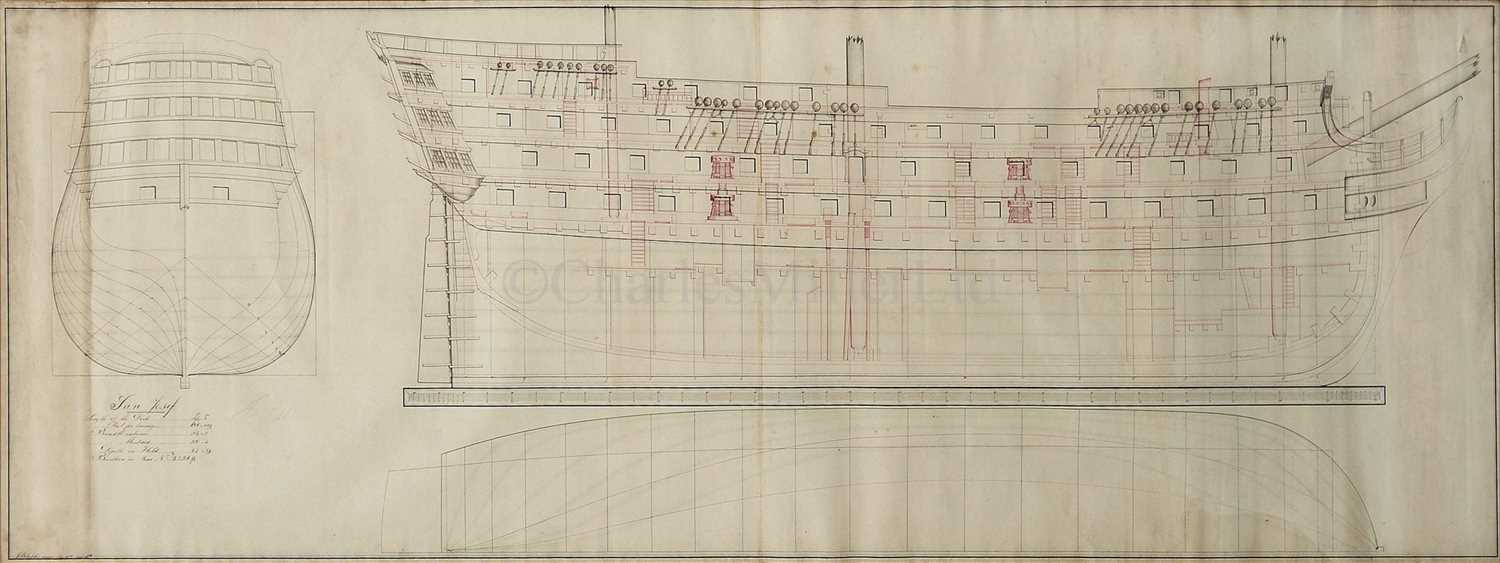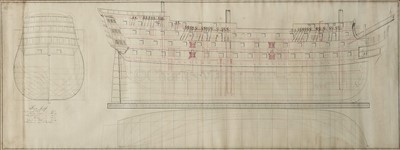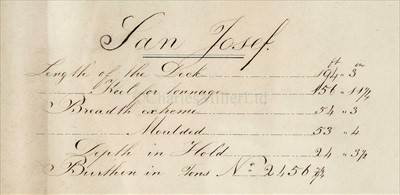21st Oct, 2009 12:00
Maritime and Scientific Models, Instruments & Art (Victory)
52
[M] AN HISTORICALLY INTERESTING EARLY 19TH-CENTURY...
AN HISTORICALLY INTERESTING EARLY 19TH-CENTURY ADMIRALTY SHEER DRAUGHT PROFILE DRAWING FOR THE SAN JOSEF, CAPTURED BY NELSON'S 'PATENT BRIDGE' AT THE BATTLE OF CAPE ST. VINCENT, 14TH FEBRUARY, 1797
in black and red inks with watercolour shading to masts and blocks, inscribed under stern view lower left San Josef with her specifications listed under, and signed 'J. Lobb' with further annotation in margin reading: J.B. Lobb Comd. May 16th finsd. 30th (lower left), over two conjoined sheets - 26 x 76½in. (66 x 194.3cm.) Temporary display frame
In 1796, the French invaded the north of Italy, and Spain made an alliance with the French republic. Nelson, at this time, had already been involved in important British actions against the French, at Corsica (where a shot had struck the gravel bank where he stood, driving debris into his right eye and destroying his sight in that eye, and in frustrating French movement and trade in the Gulf of Genoa. The Battle of Cape St. Vincent, fought on 14 February 1797, against the Spanish fleet was to show him as a man of quite exceptional ability and tactical brilliance.
At a certain point in the battle, the English line had cut the Spanish fleet into two parts. Nelson, who was commanding the rear in the Captain, observed that the Spanish leading ships were bearing up so as to pass astern of the English line and regroup. He set the course of the Captain to obstruct their progress and engaged the largest ship then afloat, the Spanish flagship Santisima Trinidad, providing a delay which enabled other English ships to come up in support. The Captain suffered many losses in the engagement and Nelson, finding her unmanageable, laid her alongside the San Nicolas which he carried by boarding. The San Nicolas had itself fallen on the San Josef and Nelson therefore boarded the San Josef and took her surrender. When the fighting was over, he boarded the Victory, where the Admiral of the British Fleet, Sir John Jervis, gratefully embraced him. In recognition of his conduct he was made a Knight Companion of the Bath and was promoted to the rank of Rear Admiral. He incorporated the stern of the San Josef within his armorial crest, still proudly carrying the ship's name.
Latterly in 1809 San Josef served as Flagship to Sir John Duckworth and it has been suggested that this plan was taken as part of a refit prior to his command. J.B. Lobb has yet to be identified, but is thought to be one of the Admiralty draughtsmen employed at Plymouth, or possibly a local architect hired as occasion required for his drawing skills.
in black and red inks with watercolour shading to masts and blocks, inscribed under stern view lower left San Josef with her specifications listed under, and signed 'J. Lobb' with further annotation in margin reading: J.B. Lobb Comd. May 16th finsd. 30th (lower left), over two conjoined sheets - 26 x 76½in. (66 x 194.3cm.) Temporary display frame
In 1796, the French invaded the north of Italy, and Spain made an alliance with the French republic. Nelson, at this time, had already been involved in important British actions against the French, at Corsica (where a shot had struck the gravel bank where he stood, driving debris into his right eye and destroying his sight in that eye, and in frustrating French movement and trade in the Gulf of Genoa. The Battle of Cape St. Vincent, fought on 14 February 1797, against the Spanish fleet was to show him as a man of quite exceptional ability and tactical brilliance.
At a certain point in the battle, the English line had cut the Spanish fleet into two parts. Nelson, who was commanding the rear in the Captain, observed that the Spanish leading ships were bearing up so as to pass astern of the English line and regroup. He set the course of the Captain to obstruct their progress and engaged the largest ship then afloat, the Spanish flagship Santisima Trinidad, providing a delay which enabled other English ships to come up in support. The Captain suffered many losses in the engagement and Nelson, finding her unmanageable, laid her alongside the San Nicolas which he carried by boarding. The San Nicolas had itself fallen on the San Josef and Nelson therefore boarded the San Josef and took her surrender. When the fighting was over, he boarded the Victory, where the Admiral of the British Fleet, Sir John Jervis, gratefully embraced him. In recognition of his conduct he was made a Knight Companion of the Bath and was promoted to the rank of Rear Admiral. He incorporated the stern of the San Josef within his armorial crest, still proudly carrying the ship's name.
Latterly in 1809 San Josef served as Flagship to Sir John Duckworth and it has been suggested that this plan was taken as part of a refit prior to his command. J.B. Lobb has yet to be identified, but is thought to be one of the Admiralty draughtsmen employed at Plymouth, or possibly a local architect hired as occasion required for his drawing skills.
Sold for £5,208
Estimated at £3,000 - £4,000
(inc. buyer's premium of 24%)
AN HISTORICALLY INTERESTING EARLY 19TH-CENTURY ADMIRALTY SHEER DRAUGHT PROFILE DRAWING FOR THE SAN JOSEF, CAPTURED BY NELSON'S 'PATENT BRIDGE' AT THE BATTLE OF CAPE ST. VINCENT, 14TH FEBRUARY, 1797
in black and red inks with watercolour shading to masts and blocks, inscribed under stern view lower left San Josef with her specifications listed under, and signed 'J. Lobb' with further annotation in margin reading: J.B. Lobb Comd. May 16th finsd. 30th (lower left), over two conjoined sheets - 26 x 76½in. (66 x 194.3cm.) Temporary display frame
In 1796, the French invaded the north of Italy, and Spain made an alliance with the French republic. Nelson, at this time, had already been involved in important British actions against the French, at Corsica (where a shot had struck the gravel bank where he stood, driving debris into his right eye and destroying his sight in that eye, and in frustrating French movement and trade in the Gulf of Genoa. The Battle of Cape St. Vincent, fought on 14 February 1797, against the Spanish fleet was to show him as a man of quite exceptional ability and tactical brilliance.
At a certain point in the battle, the English line had cut the Spanish fleet into two parts. Nelson, who was commanding the rear in the Captain, observed that the Spanish leading ships were bearing up so as to pass astern of the English line and regroup. He set the course of the Captain to obstruct their progress and engaged the largest ship then afloat, the Spanish flagship Santisima Trinidad, providing a delay which enabled other English ships to come up in support. The Captain suffered many losses in the engagement and Nelson, finding her unmanageable, laid her alongside the San Nicolas which he carried by boarding. The San Nicolas had itself fallen on the San Josef and Nelson therefore boarded the San Josef and took her surrender. When the fighting was over, he boarded the Victory, where the Admiral of the British Fleet, Sir John Jervis, gratefully embraced him. In recognition of his conduct he was made a Knight Companion of the Bath and was promoted to the rank of Rear Admiral. He incorporated the stern of the San Josef within his armorial crest, still proudly carrying the ship's name.
Latterly in 1809 San Josef served as Flagship to Sir John Duckworth and it has been suggested that this plan was taken as part of a refit prior to his command. J.B. Lobb has yet to be identified, but is thought to be one of the Admiralty draughtsmen employed at Plymouth, or possibly a local architect hired as occasion required for his drawing skills.
in black and red inks with watercolour shading to masts and blocks, inscribed under stern view lower left San Josef with her specifications listed under, and signed 'J. Lobb' with further annotation in margin reading: J.B. Lobb Comd. May 16th finsd. 30th (lower left), over two conjoined sheets - 26 x 76½in. (66 x 194.3cm.) Temporary display frame
In 1796, the French invaded the north of Italy, and Spain made an alliance with the French republic. Nelson, at this time, had already been involved in important British actions against the French, at Corsica (where a shot had struck the gravel bank where he stood, driving debris into his right eye and destroying his sight in that eye, and in frustrating French movement and trade in the Gulf of Genoa. The Battle of Cape St. Vincent, fought on 14 February 1797, against the Spanish fleet was to show him as a man of quite exceptional ability and tactical brilliance.
At a certain point in the battle, the English line had cut the Spanish fleet into two parts. Nelson, who was commanding the rear in the Captain, observed that the Spanish leading ships were bearing up so as to pass astern of the English line and regroup. He set the course of the Captain to obstruct their progress and engaged the largest ship then afloat, the Spanish flagship Santisima Trinidad, providing a delay which enabled other English ships to come up in support. The Captain suffered many losses in the engagement and Nelson, finding her unmanageable, laid her alongside the San Nicolas which he carried by boarding. The San Nicolas had itself fallen on the San Josef and Nelson therefore boarded the San Josef and took her surrender. When the fighting was over, he boarded the Victory, where the Admiral of the British Fleet, Sir John Jervis, gratefully embraced him. In recognition of his conduct he was made a Knight Companion of the Bath and was promoted to the rank of Rear Admiral. He incorporated the stern of the San Josef within his armorial crest, still proudly carrying the ship's name.
Latterly in 1809 San Josef served as Flagship to Sir John Duckworth and it has been suggested that this plan was taken as part of a refit prior to his command. J.B. Lobb has yet to be identified, but is thought to be one of the Admiralty draughtsmen employed at Plymouth, or possibly a local architect hired as occasion required for his drawing skills.
Auction: Maritime and Scientific Models, Instruments & Art (Victory), 21st Oct, 2009


